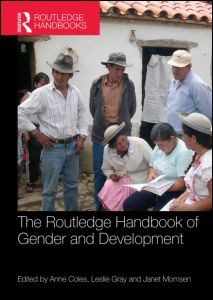The Routledge Handbook of Gender and Development

This handbook brings together academics, practitioners and policymakers to explore a wide range of issues in gender and development. Eight broad themes are addressed: the field of gender and development; environmental resources; population and poverty; health, survival and services; mobilities; conflict and post-conflict; economics; and development organizations. The chapters tend to be short, making this more of a primer than an exhaustive look at any particular topic.
The handbook shows the breadth of the field. It includes both commonly addressed subjects (sex trafficking, women and microcredit) and smaller niches (indigenous women and fire knowledge, gender and mining). One of the chapters most relevant to Environment and Urbanization centres on gender and urban poverty. This rejects the dichotomous view that urban = damaging / rural = wholesome, instead showing the benefits of urbanization on female health and opportunities. One example is the reduction of infant mortality in Europe following investments in water and sanitation in the early 20th century. Another example is the reduction in sex-selective abortions in South Korea over the past couple of decades. In that country, as females have increasingly gained access to economic opportunities associated with urbanization, son preference has declined. In general, however, while urban life is often associated with more equal gender relations, there are persistent disparities between men and women in cities. Some of these, such as the growing number of widows in poor cities, will become more severe in the coming years.
The Routledge Handbook of Gender and Development also explores the discipline’s history. It demonstrates that despite the progress that has been made in the 40-odd years of the gender and development field, it remains an important policy area, constantly fertilized by new developments. One of these is the transnational market in surrogacy. This chapter describes how India has become the “Cradle of the World”, in which reproduction is outsourced from the global North to the South due to the enormous differences in surrogacy fees and levels of income. Indian surrogates can supplement their income by five times, yet their reproductive services come with health and emotional costs. This chapter argues for careful study and regulation, rather than value judgements, of the expanding reproductive market.
Of course, while this particular market is a recent development owing to technological advancements and global demographic change, there is a long history of scrutinizing the female body for what it reveals about economics, social patterns and class relations. (The handbook’s chapter on gender relations in aid organizations provides one example.) Thus, the wide scope of the handbook enables connections to be drawn between seemingly disparate topics and across different periods and locations.
Book note prepared by Christine Ro
Further reading:
Environment and Urbanization (2013), “Gender and urban change”, Vol 25, No 1, available at http://eau.sagepub.com/content/25/1.
Search the Book notes database
Our Book notes database contains details and summaries of all the publications included in Book notes since 1993 - with details on how to obtain/download.
Use the search form above, or visit the Book notes landing page for more options and latest content.
For a searchable database for papers in Environment and Urbanization, go to http://eau.sagepub.com/

